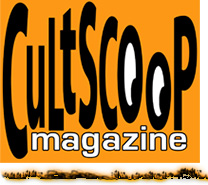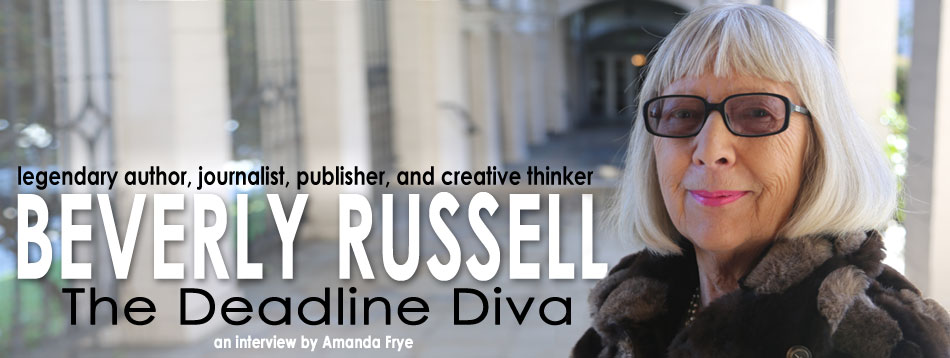|
|||||||||||||||||||||||||||||||||||||||||||||||||||||||||||||||||||||||||||||||||||||||||||||||||||||||||||||||||||||||||||||||||||||||||||||||||||||||||||||||
|
In 1991, she launched Beverly Russell Enterprises. She acts as a creative consultant to major corporations and educational establishments, formulating traveling exhibitions, nation-wide seminar programs, and other promotional activities to enhance corporate and educational themes.
She authored and packaged a number of best-selling books on architecture, design, and cuisine, as well as inspirational books, including ASK THE FLOWERS, THE ADVENTURES OF KUNDUN THE GOLDEN CAT, CROSSINGS, ESPACIOS, and LINES ON AGING. Her most recent self-published work is her memoir, DEADLINE DIVA: A JOURNALIST'S LIFE. Amanda Frye had a chance to sit down with her friend Beverly Russell for this interview. BEVERLY RUSSELL: I was pushed into writing my memoir by a very close friend I have known since 1970, Paula Rice Jackson. She is a book packager and thought it would be an interesting story.
AF: You describe yourself as a "creative thinker." Can you explain this label and what it means? BR: Johnson O'Connor a corporate consulting group defined my personality in one of their tests as a linear thinker, sort of one, two, three flow when presented with a challenge. I have an ability to think up ideas and solutions easily. AF: When did you first know that you wanted to be a writer? Describe the story of writing your first book. AF: How did your English roots influence your career? BR: As an elder child, my sister was four years younger and needed a lot of attention from my mother, I spent a lot of time alone reading. There is a tradition in England of reading bedtime stories. I still cannot go to bed without reading. But English education (at that time!) focused on the classics, Latin and Greek and the myths. We used to act out these narratives in plays.
AF: Who had the greatest influence on your career?
BR: The Editor in Chief of the Manchester Evening News, Wales Thomas, my boss at my first job in Fleet Street, used to have me in tears. He used to push me to write. Barbara Tober, the Editor in Chief at Bride's also had me in tears. I was fortunate to have editors of substance who critiqued my writing and drove me on despite the negative comments they gave me. AF: In DEADLINE DIVA you reveal intimate details of your love lives. How have your family and friends reacted to publishing such titillating descriptions of your relationships and lovers? BR: I hate to say it, but there were several other lovers I did not mention. Remember this was the 1970's – letting it all hang out, especially in New York – taking a cue from San Francisco.
Looking back, I do not regret any of these serial relationships. One was a blue-collar worker who had been in prison. (I never did find out why and it was a very brief liaison.) But my friends were keen to meet him. As a journalist, I was ready to go through unexpected doors.
My second husband was a bit miffed about the chapter focused on him, but on the whole I felt I gave him a good rap. AF: I was pleased to discover that we are both Sagittarius. Tell me, how you think being a Sagittarius has influenced your life. BR: The astrological sign of the archer, Sagittarius, describes movement and action. I have lived in five countries and 29 different "homes." The astronomer/astrologer Wendy Ashley unraveled the significant aspects of my birth date and place. The archer shoots out information in short bursts – typical of a journalist's occupation. AF: As editor of Interiors you have seen many changes in architecture and design. How has the computer age and do-it-yourself era influenced this area? What do you see happening in the future?
BR: Architecture develops in phases like everything else in the creative realm – fashion, fine arts, graphics. The book I have just completed out this year, 2015, FIFTY UNDER FIFTY – INNOVATORS OF THE 21ST CENTURY – reports on the efforts of architects and designers in 19 countries to deal with today's realities – over population, ecological and climate changes, human needs. In the 1980's by contrast, the front-runners in the field were labeled "starchitects" and were notorious for cloud-tickling skyscrapers and glamor residences. AF: You've seen many changes in journalism since the days of phoning in a story to self-publishing on the internet. What elements do you see as the same and what challenges exist for journalist in the future? BR: The art and craft of journalism is "over" as I know it and experienced it. The internet has helped millions on planet earth to have a say, to write, to photograph, and put forward a point of view. There are no "editors" or mentors out there editing all this information, some of it "misinformation." To the 20th century generation of writers and other creatives, the trend is interpreted as a dumbing down of professional creativity. The blurry photos and videos from cell phones will never be art works on a level with a gifted professional photographer's vision and skill. But maybe, we must be conscious of compromising and accepting a new norm.
AF: You have covered royalty, celebraties, presidents, first ladies, and many other rich and famous people. What was your favorite interview and encounter? Which was the most surprising? Who was your least favorite interview? BR: Perhaps the most memorable encounters were going to Buckingham Palace in London, to a Royal Garden Party, and the White House in Washington, D.C to do interviews. Most people never penetrate inside these gates in their lifetime. Another compelling memory is flying on the Concorde from New York to Paris, now a journey nobody will ever experience. You could see the curve of the earth.
Least favorite interview: Cary Grant, described in DEADLINE DIVA. AF: What do you see as the biggest challenge in journalism today? BR: The biggest challenge has been to transition from the traditional journalistic / publishing scenario to the 21st century scenario. Since 2008, book, newspaper and magazine publishing has been diminishing.
AF: Book publishing is undergoing a major change towards Indie Publishing and using social media. Where do you see this trend going? BR: In 2008 I wrote and published my first indie book THE ADVENTURES OF KUNDUN THE GOLDEN CAT. Although I approached traditional publishers with this book, none took it up. Nor, was it publicized in traditional review publications. At that time, the indie publishing was black listed, and cast as amateur.
Since then, Indie Publishing has become almost mainstream, but that does not mean that traditional publishers have embraced this new norm. The indie publisher has to get out there and market and distribute the product. It took me sometime to realize how to do this. It is easy to get an indie book on Amazon, but how do you sell it if people don't know it exists?
I was fortunate with a "cat" book to give marketing and promotion events with animal rescue institutions and sell books to their constituents. That does not mean I made profits. I broke even during the first year. But in 2015, I understood a little better how to get indie publishing profitable…
You must put the product out there on social media and gain followers. Once you have hundreds, or hopefully thousands of followers, you can begin to sell advertising spots to product manufacturers who want to reach your "followers." In terms of the "cat" book, these followers would attract pet food companies, for example. I must confess that this is an entirely new way to think of making money, and having a career as a successful writer, and I am not properly educated to do it myself. To get these social media followers, you need the help of a digital savvy person. For instance, with my 2013 book indie LINES ON AGING, if I attracted the "senior" market, perhaps this would be attractive to pharmaceutical or cosmetic companies, or institutions such as AARP. These possibilities present a whole new way of perceiving opportunities in publishing. Anyone thinking of a writing career today, will obviously pursue this 21st century scenario. AF: If you could go back and live one part of your life over, what would it be? What would you keep the same and what would you change? BR: I never regret anything in the past. I just keep moving forward. The future at 81 is now very flimsy. I live day-by-day with all my memories and am glad I had all these opportunities.
Beverly Russell web links: |
|||||||||||||||||||||||||||||||||||||||||||||||||||||||||||||||||||||||||||||||||||||||||||||||||||||||||||||||||||||||||||||||||||||||||||||||||||||||||||||||



























